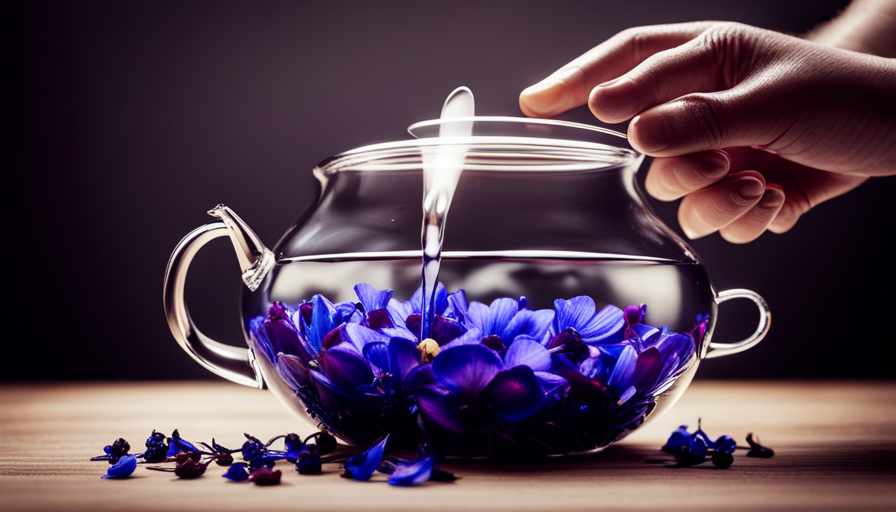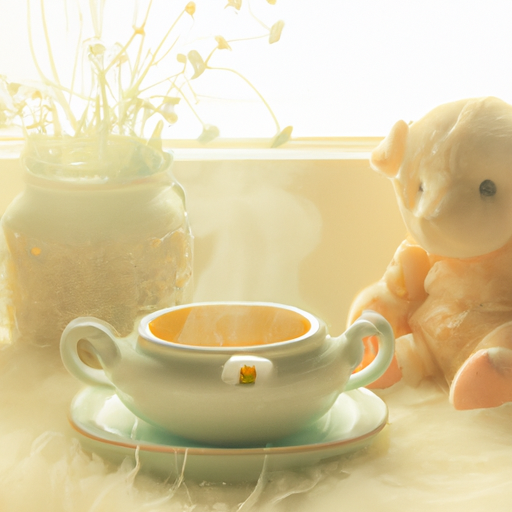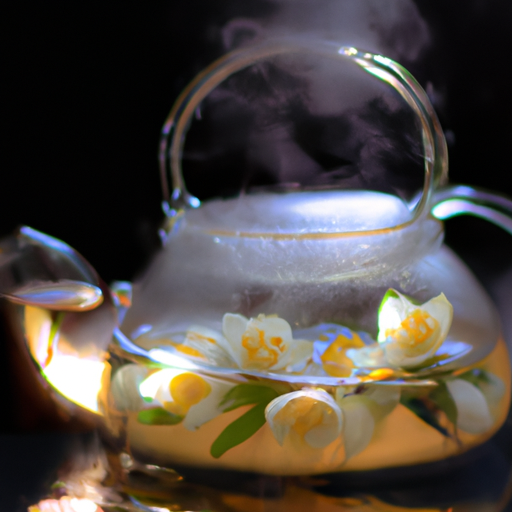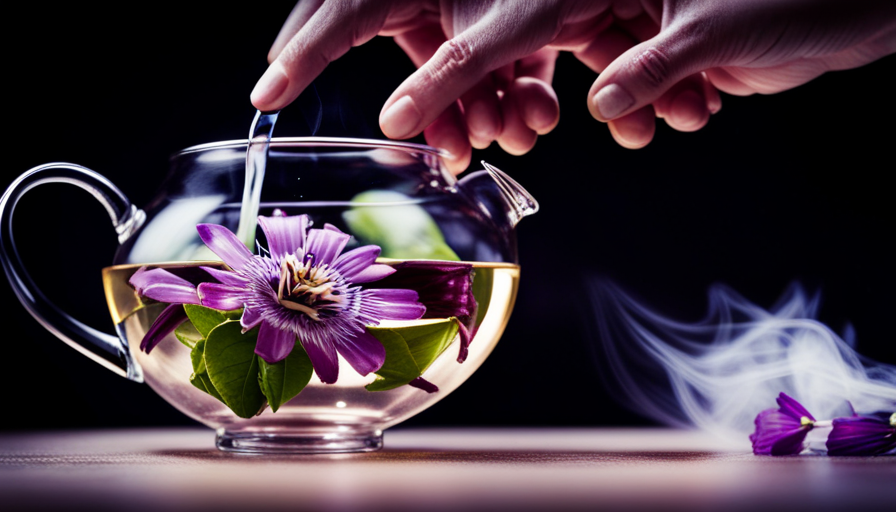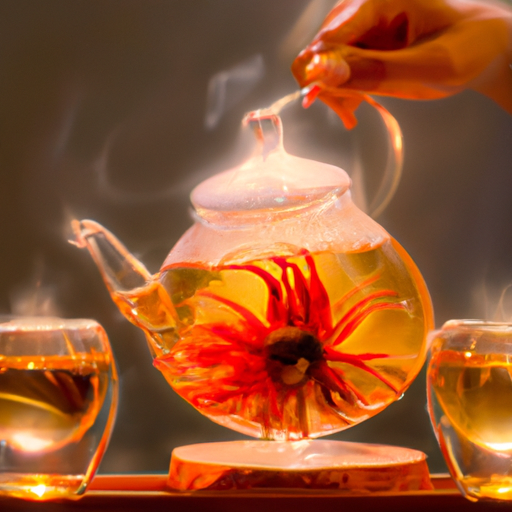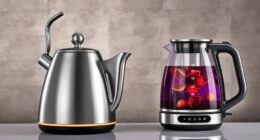When it comes to enjoying a hot cup of tea, the possibilities are endless. Have you ever thought about adding a pop of vibrant blue to your tea mug?
Blue pea flower tea, also known as butterfly pea tea, is a stunning beverage that not only captivates with its striking hue but also boasts a plethora of health benefits.
In this article, I will guide you through the process of making this enchanting tea, from gathering the delicate blue pea flowers to brewing the perfect cup. Get ready to embark on a journey of flavors and colors as we explore the history, cultural significance, and other uses of this fascinating flower.
So, grab your teapot and let’s dive into the world of blue pea flower tea!
Key Takeaways
- Blue pea flower tea is rich in antioxidants and can help protect against chronic diseases.
- It supports digestive health and acts as a natural diuretic.
- Blue pea flower tea promotes healthy skin and hair.
- The tea can be brewed using dried blue pea flowers and enjoyed hot or cold.
Introduction to Blue Pea Flower Tea
Blue pea flower tea, with its vibrant blue color, is a refreshing and visually stunning beverage that’s made from the petals of the blue pea flower. This unique tea has gained popularity not only for its striking appearance, but also for its numerous health benefits.
To brew blue pea flower tea, start by boiling water in a kettle. Once the water reaches a rolling boil, remove it from the heat and add a handful of blue pea flower petals. Allow the petals to steep for about 5-10 minutes, or until the water turns a deep blue hue. Strain the tea to remove the petals and pour it into a cup.
Blue pea flower tea is rich in antioxidants, which help protect the body against free radicals and reduce the risk of chronic diseases. It’s also known to have anti-inflammatory properties and can aid in digestion. Additionally, this tea is a natural diuretic, which may help cleanse the body and promote healthy kidney function.
With its vibrant blue color and numerous health benefits, blue pea flower tea isn’t just a visually appealing beverage but also a great addition to a healthy lifestyle.
Benefits of Blue Pea Flower Tea
Blue Pea Flower Tea is rich in antioxidants, which play a crucial role in protecting our cells from damage caused by free radicals. These antioxidants help to reduce inflammation and prevent oxidative stress in our bodies.
Additionally, Blue Pea Flower Tea supports digestive health by promoting the growth of beneficial gut bacteria and aiding in digestion.
It also contains compounds that can improve the health of our skin and hair, promoting a youthful appearance and healthy growth.
Rich in Antioxidants
To make the tea, all you need is a handful of dried blue pea flowers and boiling water. This will provide you with a beverage that’s incredibly rich in antioxidants. Studies show that blue pea flower tea contains over 10 times the amount of antioxidants as green tea. Antioxidants are important for our health as they help protect our cells from damage caused by harmful molecules called free radicals.
Blue pea flower tea can help reduce the risk of chronic diseases such as heart disease and cancer. It also has anti-inflammatory properties, which can help alleviate symptoms of inflammation in the body. Furthermore, blue pea flower tea can boost our immune system, helping us fight off infections and illnesses. So not only does this tea taste delicious, but it also provides numerous health benefits.
Transitioning into the next section, blue pea flower tea also supports digestive health by promoting healthy digestion and soothing the digestive system.
Supports Digestive Health
Brewing a handful of dried blue pea flowers in boiling water creates a vibrant elixir that nourishes and soothes the digestive system, promoting optimal digestive health. Blue pea flower tea has long been used as a natural remedy for digestive issues, thanks to its powerful medicinal properties.
The importance of gut health cannot be overstated, as it plays a crucial role in our overall well-being. Blue pea flower tea contains antioxidants that help reduce inflammation and protect the gut lining from damage. It also acts as a mild laxative, aiding in regular bowel movements and preventing constipation.
Additionally, the tea helps to balance the gut microbiome by promoting the growth of beneficial bacteria. This supports proper digestion and nutrient absorption. As we transition into the next section about promoting healthy skin and hair, it’s important to note that a healthy gut is essential for radiant skin and lustrous hair.
Promotes Healthy Skin and Hair
Indulging in this vibrant elixir will have my skin and hair feeling fabulously radiant and lustrous. Blue pea flower tea isn’t just a treat for the taste buds but also promotes overall wellness, especially for our skin and hair.
Packed with antioxidants and flavonoids, this tea helps combat free radicals, reducing the signs of aging and promoting a youthful glow. The natural compounds found in blue pea flowers also have anti-inflammatory properties, soothing irritated skin and preventing breakouts. Additionally, the tea’s high content of anthocyanins supports hair health, strengthening the follicles and promoting healthy growth.
Apart from its numerous benefits for the skin and hair, blue pea flower tea can also be used in various culinary creations, adding a vibrant blue hue to dishes and beverages.
Transitioning into the next section, let’s now explore how to gather these beautiful blue pea flowers.
Gathering Blue Pea Flowers
When gathering blue pea flowers, I usually find them growing in tropical regions, particularly in Southeast Asia. These flowers thrive in warm and humid climates, so you can often find them in countries like Thailand, Malaysia, and Indonesia.
Harvesting the flowers is a delicate process, as you want to ensure that you’re picking them at the peak of their freshness and vibrancy. Once harvested, it’s important to dry the flowers properly to preserve their color and flavor, as they can be used for various purposes such as making tea or natural food coloring.
Where to Find Blue Pea Flowers
If you’re looking for a unique and vibrant ingredient, you can easily find blue pea flowers at specialty tea shops or online retailers. Buying online is a convenient option, as it allows you to browse through a wide range of suppliers and compare prices.
Many reputable online retailers offer dried blue pea flowers, which can be delivered right to your doorstep. On the other hand, if you prefer a more hands-on approach, you can also consider growing blue pea flowers at home. These beautiful plants thrive in warm climates and require well-drained soil and ample sunlight. By nurturing your own blue pea flower plant, you not only have a steady supply of fresh flowers but also the satisfaction of witnessing their growth.
Once you have harvested and dried the flowers, you can proceed to the next step of preparing your refreshing blue pea flower tea.
Harvesting and Drying the Flowers
After finding a reliable source of blue pea flowers, it’s time to start the process of harvesting and drying them.
Blue pea flowers thrive in tropical climates, requiring warm temperatures and ample sunlight to grow successfully. They also prefer well-drained soil and regular watering to ensure optimal growth.
When harvesting the flowers, it’s important to select those that are fully bloomed and vibrant in color. Gently pluck the flowers from the stem, being careful not to damage them.
Once harvested, the flowers can be dried using various methods such as air drying or using a food dehydrator. Air drying involves spreading the flowers in a single layer on a clean surface and allowing them to dry for several days. Alternatively, a food dehydrator set to a low temperature can expedite the drying process.
Once the flowers are completely dry, they can be stored in an airtight container until ready to use.
Now that we have our dried blue pea flowers, let’s move on to the exciting part – brewing blue pea flower tea.
Brewing Blue Pea Flower Tea
To brew your delicious blue pea flower tea, start by gently pouring hot water over the vibrant blue petals, creating a mesmerizing infusion that’ll transport you to a serene garden oasis.
Blue pea flower tea isn’t just visually stunning but also offers a range of health benefits. The secret lies in steeping blue pea flowers, scientifically known as Clitoria ternatea, which contain natural antioxidants and anthocyanins that promote overall well-being.
To make the perfect cup of blue pea flower tea, use about 5 to 6 dried flowers for every 8 ounces of water. Boil the water to around 200°F (93°C) for optimal extraction of flavors and antioxidants. Once the water’s reached the desired temperature, pour it slowly over the petals, allowing them to bloom and release their vibrant blue color. Let the tea steep for about 5 to 10 minutes, depending on your preference for strength.
After steeping, strain the tea to remove the flower petals. The resulting liquid will have a beautiful blue hue, which can be enhanced with a squeeze of lemon juice. This refreshing tea can be enjoyed hot or cold, making it a versatile beverage for any time of the year.
Transitioning to the next section about serving and enjoying blue pea flower tea, let’s explore the various ways to savor this delightful brew without compromising its delicate flavors.
Serving and Enjoying Blue Pea Flower Tea
When it comes to serving and enjoying Blue Pea Flower Tea, there are a few key considerations to keep in mind. First, deciding between hot or iced tea can greatly impact the flavor profile and overall experience.
Additionally, garnishing and presentation ideas can elevate the visual appeal and aesthetic pleasure of the tea.
By exploring these factors, one can fully appreciate the versatility and beauty of Blue Pea Flower Tea.
Hot vs. Iced Blue Pea Flower Tea
If you’re looking for a refreshing twist on blue pea flower tea, try brewing it as an iced beverage instead of a hot one. While both versions of blue pea flower tea offer unique taste profiles, the iced version brings a cooling and thirst-quenching element to the table. Not only does it provide a delightful sensation on a hot summer day, but it also retains the numerous health benefits of blue pea flower tea. Blue pea flower tea is known for its antioxidant properties and potential to support brain health. To help you decide which version to try, here’s a comparison between hot and iced blue pea flower tea:
| Hot Blue Pea Flower Tea | Iced Blue Pea Flower Tea | |
|---|---|---|
| Taste | Rich and aromatic | Refreshing and crisp |
| Temperature | Warm and soothing | Cold and invigorating |
| Serving | Enjoyed slowly | Sipped quickly |
Now that you have a better understanding of the differences, let’s explore some garnishing and presentation ideas for your blue pea flower tea.
Garnishing and Presentation Ideas
Get creative with your garnishes and presentation to elevate the visual appeal of your refreshing blue pea flower tea. Here are some garnishing techniques and creative serving ideas to make your tea truly stand out:
- Add a sprig of fresh mint or basil to enhance the aroma and add a pop of green color.
- Place a slice of lemon or lime on the rim of the glass for a citrusy touch.
- Use edible flowers like lavender or rose petals to add elegance and beauty.
- Experiment with different glassware, such as mason jars or vintage teacups, to create a unique and charming presentation.
- For a tropical twist, serve your blue pea flower tea in a coconut shell or a hollowed-out pineapple.
These garnishing techniques and creative serving ideas won’t just make your blue pea flower tea visually appealing, but they’ll also add an extra layer of flavor and excitement.
Now, let’s explore the various blue pea flower tea variations.
Blue Pea Flower Tea Variations
When it comes to blue pea flower tea, there are endless possibilities for variations by adding other herbal ingredients. You can create unique flavors and enhance the tea’s health benefits by combining blue pea flowers with herbs like lemongrass or ginger.
In addition, mixing blue pea flower tea with other tea types, such as green tea or black tea, can create exciting flavor profiles and add a new dimension to your tea experience.
Experimenting with different combinations of herbal ingredients and tea types allows for a personalized and diverse range of blue pea flower tea variations.
Adding Other Herbal Ingredients
To enhance the flavor and health benefits of your blue pea flower tea, you can easily incorporate other herbal ingredients. Here are four herbal tea combinations that not only complement the floral notes of blue pea flowers but also offer additional health benefits:
-
Chamomile: Adding chamomile to your blue pea flower tea can promote relaxation, reduce anxiety, and improve sleep quality.
-
Lemon balm: This citrusy herb adds a refreshing twist to your tea, boosting its antioxidant properties and supporting digestion.
-
Mint: By combining blue pea flowers with mint leaves, you create a soothing blend that can alleviate headaches, aid digestion, and freshen breath.
-
Ginger: Adding ginger to your blue pea flower tea enhances its anti-inflammatory properties, aids in digestion, and can relieve nausea.
By incorporating these herbal ingredients, you can create a unique and beneficial blend of flavors and health benefits. Now, let’s explore the next section about mixing blue pea flower tea with other tea types.
Mixing with Other Tea Types
If you want to take your tea game to the next level, why not try mixing blue pea flower tea with different types of tea for a delightful fusion of flavors? Tea pairing is a great way to explore new taste profiles and enhance your tea experience.
Blue pea flower tea, with its vibrant blue color and earthy taste, complements various tea varieties beautifully. For a refreshing twist, try mixing it with green tea for a subtle grassy flavor and added antioxidants. If you prefer a bolder taste, black tea pairs well with blue pea flower tea, creating a rich and robust blend.
Additionally, mixing herbal teas like chamomile or lemongrass with blue pea flower tea can provide a soothing and aromatic infusion. Not only does tea pairing offer a diverse range of flavors, but it also combines the health benefits of different teas.
Transitioning to the subsequent section about storing blue pea flower tea, it’s important to maintain freshness to preserve its flavors and benefits.
Storing Blue Pea Flower Tea
When it comes to storing blue pea flower tea, proper techniques are essential to maintain its quality.
The shelf life of blue pea flower tea can be extended by storing it in an airtight container in a cool and dark place.
To ensure freshness, it’s recommended to consume blue pea flower tea within six months of purchase.
Proper Storage Techniques
Store your blue pea flower tea in an airtight container to keep it fresh and preserve its vibrant blue color. Proper storage methods are crucial for preserving the freshness and quality of your blue pea flower tea.
When exposed to air, light, and moisture, the tea can lose its vibrant blue color and its flavor can deteriorate. To ensure the longevity of your tea, choose a container that’s airtight and opaque, like a glass jar with a tight-fitting lid. Keep the container in a cool, dark place away from direct sunlight and moisture.
Avoid storing it near strong-smelling substances as tea can absorb odors easily. By following these storage techniques, you can enjoy your blue pea flower tea for a longer period of time and savor its delightful taste and mesmerizing blue hue.
Moving on to shelf life and freshness tips, it’s important to understand how long your blue pea flower tea can last and how to determine its freshness without compromising the subsequent section.
Shelf Life and Freshness Tips
To ensure your blue pea flower tea stays fresh and maintains its quality, it’s important to understand its shelf life and how to gauge its freshness. Blue pea flower tea typically has a shelf life of about 1 to 2 years when stored properly. To preserve its freshness, follow these shelf life tips:
- Store the tea in an airtight container to prevent exposure to air and moisture.
- Keep the tea away from direct sunlight and heat, as they can degrade its flavor and color.
To gauge the freshness of your blue pea flower tea, pay attention to its color and aroma. Fresh tea should have vibrant blue or purple hues and a fragrant floral scent. If the tea has turned dull or has a musty smell, it may have lost its freshness.
Now that you know how to preserve the freshness of your blue pea flower tea, let’s dive into the fascinating history and cultural significance of this delightful beverage.
The History and Cultural Significance of Blue Pea Flower Tea
Imagine yourself transported back in time, where the vibrant blue hue of Blue Pea Flower Tea was revered for its cultural significance and used in ancient rituals and ceremonies. The history of Blue Pea Flower Tea dates back centuries, originating in Southeast Asia. It was not only cherished for its distinct flavor, but also for its medicinal properties and stunning visual appeal. In many cultures, Blue Pea Flower Tea was considered a symbol of beauty, purity, and spiritual enlightenment.
To truly understand the cultural traditions surrounding Blue Pea Flower Tea, let’s take a closer look at its history. In ancient times, it was commonly used in traditional medicine for its various health benefits, such as improving digestion, reducing anxiety, and promoting healthy skin. Its striking blue color also made it a popular ingredient in natural dyes and cosmetic products.
To further illustrate the cultural significance of Blue Pea Flower Tea, let’s explore a table showcasing its historical uses and associations:
| Cultural Tradition | Description |
|---|---|
| Ancient Rituals | Blue Pea Flower Tea was often used in sacred ceremonies and rituals, symbolizing purity and spiritual connection. |
| Traditional Medicine | It was believed to possess healing properties, offering relief from various ailments and promoting overall well-being. |
| Symbol of Beauty | The vibrant blue color of Blue Pea Flower Tea was associated with beauty and used in cosmetics and natural dyes. |
As we delve into the next section about other uses for blue pea flowers, it is important to recognize the rich history and cultural significance that has shaped its role in various traditions and practices.
Other Uses for Blue Pea Flowers
Blue Pea flowers have been utilized in culinary creations, such as desserts and beverages, adding a visually stunning and unique touch to these dishes. In addition to being steeped for tea, Blue Pea flowers can be used in various culinary applications.
The petals can be infused in cream or milk to create a vibrant blue color, which can then be used to make ice cream, custards, or even blue-colored rice. The flowers can also be used as a natural dyeing agent, giving fabrics and textiles a beautiful blue hue.
When using Blue Pea flowers in cooking, it’s important to note that the color of the petals may change depending on the pH level of the ingredients they are combined with. Adding an acidic ingredient like lemon juice can turn the blue color into a purple shade, while adding an alkaline ingredient like baking soda can intensify the blue color.
Blue Pea flowers offer not only a visually appealing element to culinary creations but also a natural dyeing option for fabrics and textiles. Incorporating these flowers into your cooking can elevate the aesthetic appeal of your dishes and add a touch of uniqueness.
In the next section, we will explore some final thoughts and tips for making Blue Pea flower tea.
Final Thoughts and Tips
After exploring the various uses of blue pea flowers, it’s time to wrap up with some final thoughts and tips on brewing techniques for blue pea flower tea.
First and foremost, when making blue pea flower tea, it’s important to use high-quality dried blue pea flowers. This ensures that the tea will have a vibrant blue color and a distinct flavor. Start by boiling water and then adding the dried flowers. Let them steep for about 5-10 minutes, depending on how strong you prefer your tea. Strain out the flowers and your blue pea flower tea is ready to be enjoyed!
Here are some final thoughts and tips to keep in mind:
-
Experiment with additives: Blue pea flower tea can be enhanced with the addition of lemon juice, honey, or even a splash of coconut milk. This can alter the flavor and add a touch of sweetness or creaminess to the tea.
-
Cold brewing: Blue pea flower tea can also be enjoyed cold. Simply steep the flowers in cold water for a few hours in the refrigerator and serve over ice.
Blue pea flower tea is a unique and visually stunning herbal tea that offers a range of health benefits. With the right brewing techniques and a touch of creativity, you can enjoy a cup of blue pea flower tea that’s both delicious and visually appealing.
Frequently Asked Questions
Can blue pea flower tea be consumed by pregnant women?
During pregnancy, blue pea flower tea can be consumed in moderation. It offers various benefits, including its high antioxidant content that aids in reducing oxidative stress and inflammation. Additionally, the tea is rich in vitamins and minerals that promote overall well-being.
However, it’s important to note that excessive consumption should be avoided as it may lead to potential risks such as uterine contractions and hormonal imbalances. It’s always advisable to consult with a healthcare professional before incorporating any new beverage into your diet during pregnancy.
How long does it take for blue pea flowers to bloom?
Blue pea flowers, also known as butterfly pea flowers, are fascinating in their blooming process. Like a symphony, they gradually unfurl their delicate petals, revealing their vibrant blue hue. The blooming time varies depending on the climate and growing conditions, but typically it takes about 2 to 3 months for blue pea flowers to bloom.
Harvesting these flowers is crucial to enjoy the numerous benefits of blue pea flower tea, such as its antioxidant properties and potential cognitive enhancement.
Can blue pea flower tea help with weight loss?
Blue pea flower tea has several benefits, but weight loss is not one of them. The tea is made from the petals of the blue pea flower, which is rich in antioxidants and has anti-inflammatory properties. It can promote good digestion, boost immunity, and improve skin health. However, it’s important to note that weight loss is a complex process that requires a balanced diet and regular exercise. To make blue pea flower tea, you’ll need dried blue pea flowers and hot water.
Can blue pea flower tea be consumed hot or cold?
Blue pea flower tea can be enjoyed both hot and cold, allowing for versatility in its consumption. When served hot, it provides a comforting, soothing experience, perfect for chilly days.
On the other hand, when served cold, it offers a refreshing and rejuvenating sensation, making it an ideal choice during hot summer months.
Incorporating blue pea flower tea into various recipes not only adds a vibrant hue but also enhances the health benefits associated with this remarkable herbal infusion.
Are blue pea flowers safe to use in cooking?
Blue pea flowers are safe to use in cooking and offer various health benefits. These vibrant flowers are rich in antioxidants, which help fight inflammation and protect against chronic diseases.
They can be used in different ways, such as infusing them in oils or vinegars, adding them to salads for a pop of color, or incorporating them into baked goods for a unique twist.
Their versatility and nutritional value make blue pea flowers a great addition to any culinary repertoire.
Conclusion
In conclusion, making Blue Pea Flower Tea isn’t just a delightful experience but also offers numerous health benefits. This vibrant blue tea, derived from the petals of the Clitoria ternatea plant, is rich in antioxidants and has been used for centuries in traditional medicine.
But beyond its health benefits, this tea holds a deeper significance. It prompts us to reflect on the marvels of nature and how simple ingredients can bring joy and nourishment to our lives. So, why not indulge in the beauty of Blue Pea Flower Tea and savor its wonders?

